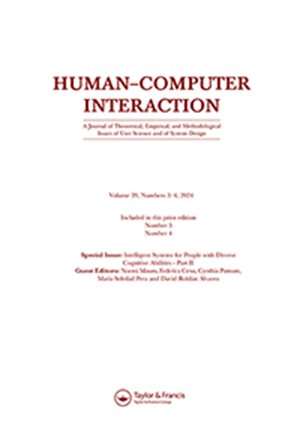人类远程操作-触觉启用的远程超声混合现实系统
IF 4.4
2区 工程技术
Q1 COMPUTER SCIENCE, CYBERNETICS
引用次数: 3
摘要
目前的远程制导方法包括口头制导和机器人远程操作,它们在精度和延迟与灵活性和成本之间存在权衡。我们提出了“人类远程操作”的新概念,它弥补了这两种方法之间的差距。实现了一个原型远程超声系统,验证了该概念的有效性。专家通过控制投射到人的场景中的虚拟超声探头,远程“遥控”一个戴着混合现实耳机的人(追随者)。跟踪器将虚拟设备的姿态和力与真实探头相匹配。将场景的姿态、力、视频、超声图像和三维网格反馈给专家。在这个控制框架中,输入和驱动是由人来完成的,但具有接近机器人的延迟和精度。这使得远程指导比口头指导更精确和快速,但比机器人远程操作更灵活和便宜。该系统经过了测试,显示了其有效性,包括0.27秒的平均操作延迟和7毫米的误差和6◦的姿态跟踪。该系统还与一名超声专家和四名患者进行了测试,发现该系统提高了两个远程超声程序的精度和速度。本文章由计算机程序翻译,如有差异,请以英文原文为准。
Human Teleoperation - A Haptically Enabled Mixed Reality System for Teleultrasound
Current teleguidance methods include verbal guidance and robotic teleoperation, which present tradeoffs between
precision and latency versus flexibility and cost. We present
a novel concept of "human teleoperation" which bridges the
gap between these two methods. A prototype teleultrasound
system was implemented which shows the concept’s efficacy. An
expert remotely "teloperates" a person (the follower) wearing a
mixed reality headset by controlling a virtual ultrasound probe
projected into the person’s scene. The follower matches the pose
and force of the virtual device with a real probe. The pose,
force, video, ultrasound images, and 3-dimensional mesh of the
scene are fed back to the expert. In this control framework,
the input and the actuation are carried out by people, but with
near robot-like latency and precision. This allows teleguidance
that is more precise and fast than verbal guidance, yet more
flexible and inexpensive than robotic teleoperation. The system
was subjected to tests that show its effectiveness, including mean
teleoperation latencies of 0.27 seconds and errors of 7 mm and
6◦ in pose tracking. The system was also tested with an expert
ultrasonographer and four patients and was found to improve
the precision and speed of two teleultrasound procedures.
求助全文
通过发布文献求助,成功后即可免费获取论文全文。
去求助
来源期刊

Human-Computer Interaction
工程技术-计算机:控制论
CiteScore
12.20
自引率
3.80%
发文量
15
审稿时长
>12 weeks
期刊介绍:
Human-Computer Interaction (HCI) is a multidisciplinary journal defining and reporting
on fundamental research in human-computer interaction. The goal of HCI is to be a journal
of the highest quality that combines the best research and design work to extend our
understanding of human-computer interaction. The target audience is the research
community with an interest in both the scientific implications and practical relevance of
how interactive computer systems should be designed and how they are actually used. HCI is
concerned with the theoretical, empirical, and methodological issues of interaction science
and system design as it affects the user.
 求助内容:
求助内容: 应助结果提醒方式:
应助结果提醒方式:


